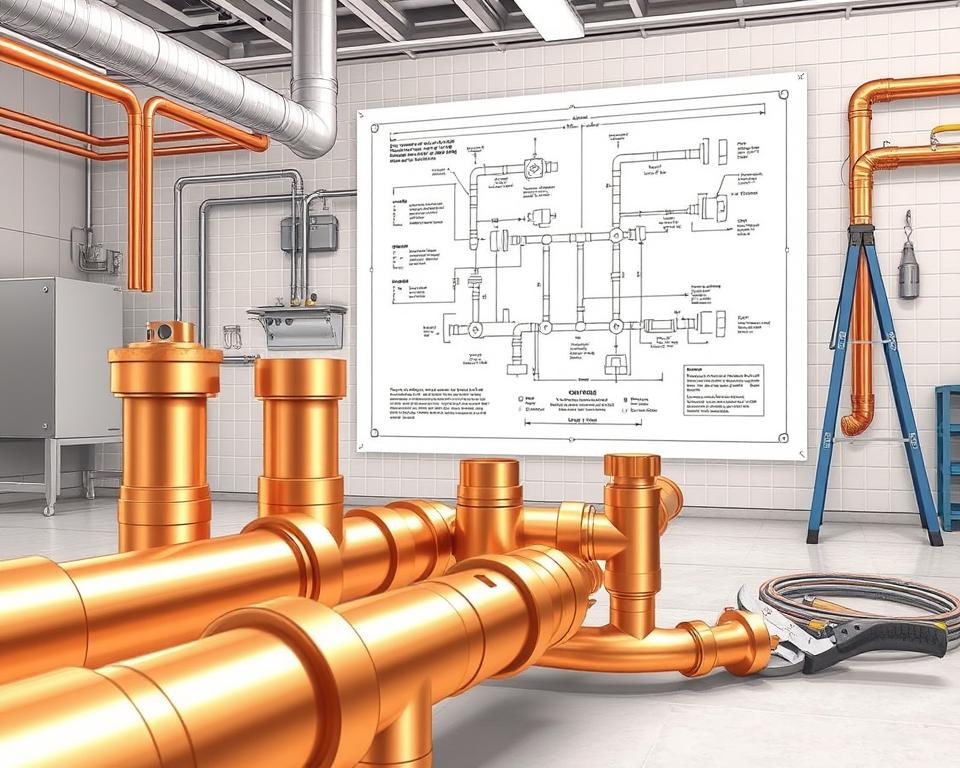Copper Gas Line Installation & Safety Reference
Did you know about 90% of tool outlets offer to cut and form threads on black iron metal piping for an additional charge? This detail demonstrates the strong demand and readily available to gas piping materials, especially copper gas lines. Many homes now favor copper for its durability, dependability, and rust resistance. This manual will discuss the basics of copper gas lines, their merits, and essential safety protocols for fitting. With perspectives from Installation Parts Supply, you’ll gain knowledge of key elements of gas line installation. This knowledge ensures both protection and adherence to codes while fulfilling your gas piping needs.
Highlight Reel
- Copper gas lines deliver robustness and resistance to corrosion.
- Fitting necessitates correct sizing and compliance with local building codes.
- Safety measures are critical to guarantee leak-proof gas lines.
- Comprehending the accurate routing and positioning is crucial for successful setup.
- Periodic servicing increases the lifespan of copper gas lines.
Grasping the Essentials of Copper Gas Lines
Copper gas lines are popular in both home and business environments. They’re appreciated for safety and dependability. Studying 5 8 copper gas line, including their advantages and how they stack up against other materials, is essential. This knowledge enables homeowners to make well-informed choices.
What is a Copper Gas Line?
A copper gas line uses copper piping for natural gas and propane distribution. It complies with established regulations like the National Fuel Gas Code (NFPA 54/ANSI Z223.1). In areas such as Minnesota and Florida, it is preferred for home fuel gas piping. Starting in 1999, agencies such as IAPMO have approved its use in fuel gas systems.
Merits of Utilizing Copper Gas Lines
Copper gas lines deliver several notable advantages. They include:
- Corrosion Resistance: Copper surpasses steel and black iron in resisting corrosion.
- Flexibility: The flexibility eases setup, even in complex layouts.
- Durability: Copper gas lines offer long life and structural integrity, thus requiring less frequent replacement.
- Safety: Complying with strict standards, copper tubing is deemed safe for gas distribution.
Comparison with Other Materials
In comparing copper and steel for gas lines, copper often wins out. Black iron pipes are still prevalent, especially in cities like Chicago. Even so, copper’s lightweight nature and simplicity of use have increased its usage. Despite about 50% of gas companies moving to stainless steel due to regulations, copper’s benefits remain significant in specific cases. This is particularly evident in regions such as St. Louis, where modern residences frequently incorporate copper gas lines.
| Required Materials | Tools for Copper Gas Line Fitting |
|---|---|
| Copper tubing (Type K and Type L) | Piping wrenches |
| Couplings and fixtures | Copper pipe cutter |
| Plumber’s tape | Soldering set |
| Safety apparatus (gloves, goggles) | Pressure gauge |
Best Practices for Copper Gas Line Installation
Installing copper gas lines entails certain optimal methods to ensure safety and efficiency. Primary elements of the process comprise accurate planning of routes, firm attachments, and rigorous leak tests. These measures guarantee a gas piping system that is both safe and in accordance with codes.
Routing and Positioning for Copper Gas Lines
Thoughtful planning is essential when placing copper gas lines. It is imperative to keep these lines distant from building elements that could inflict harm. Such an approach avoids galvanic corrosion by preventing contact with different metals. Also, securing readily accessible routes for future upkeep and fixes is a must by preserving clearances.
Adhering to these routing and positioning guidelines enhances the system’s safety and durability.
Joining and Sealing Pipes Properly
Making secure connections in copper gas pipes requires particular supplies. Employ gas-grade plumber’s tape and gas-specific sealants exclusively. Avoid regular thread seal tape to prevent leaks from lubricants on threads. By adhering to proper attachment and sealing methods, risks of gas leaks are significantly reduced, in accordance with safety and regulatory requirements.
Leak Testing Post-Installation
Post-installation, a comprehensive leak test is imperative. Begin with a pressure test, using 1.5 times the system’s maximum working pressure for at least 10 minutes. Alternatively, you may use a soapy water solution to reveal leaks through the formation of bubbles. The desired pressure for these tests should be approximately 9 inches w.c., with a slight variance allowed. These methods of leak detection are fundamental in ensuring the safety of the gas system, which secures both assets and lives.
Copper Gas Line Safety Standards
Understanding and following the various rules and guidelines is essential for copper gas line safety. These regulations ensure compliance and reduce risks such as leaks and failures. Both homeowners and contractors need to strictly adhere to local building codes. They should acquire the required permits before initiating any installation endeavors.
Grasping Local Building Code Standards
Local building codes establish the rules for installing copper gas lines. They address issues like depth of installation, necessary bracing, and methods for preventing corrosion. For underground pipes, there is usually a stipulation for 18 inches of burial. However, in some situations, this can be lowered to 12 inches. Steel sleeves are also often required for copper tubing that passes through wall plates near open edges.
Inspection and Compliance
Regular inspections by certified professionals are vital for gas line safety. They verify that installations adhere to both the National Fuel Gas Code and local building codes. These evaluations assess whether copper pipes are firmly installed and if holes made in joists are the correct size. Meeting these standards improves safety and guarantees dependable function of gas line installations over time.
Addressing Common Concerns with Copper Gas Lines
Copper gas lines, renowned for their longevity, can experience corrosion problems. It’s crucial to comprehend possible issues and essential maintenance to guarantee safety. Identifying signs of corrosion and the benefits of regular maintenance can prevent gas leaks. This knowledge alongside comparing copper to steel gas lines helps decide the best material use.
Corrosion Challenges in Copper Gas Lines
Over time, copper gas lines may corrode due to environmental factors or setup mistakes. Telltale signs include discoloration, peeling, and surprising increases in gas bills. Such damage can result in gas leakage, as evidenced by a rotten egg smell from added mercaptan. After construction or excavation, checking for visible damage is crucial.
Upkeeping Your Copper Gas Line
For safety and efficiency, upkeeping copper gas lines is essential. Yearly checks can identify initial signs of corrosion and problems. Ensuring appliances remain clean and properly ventilated prevents accumulation of gas and risks of carbon monoxide poisoning. Only qualified experts should handle repairs or installations, ensuring safety code compliance and reducing failure risks.
Comparing Copper Gas Lines to Steel: Advantages and Disadvantages
Deciding between copper and steel gas lines involves weighing pros and cons. Copper’s flexibility simplifies setup in confined areas and typically provides superior corrosion resistance. In contrast, steel lines may offer greater longevity and cost less for some projects. Understanding these factors helps in selecting the optimal material.
Bringing It All Together
The criticality of adhering to optimal methods for copper gas installation is essential. Adherence to safety standards and local codes ensures effective performance and security. The manual also underscores copper gas lines’ advantages, such as robustness and corrosion resistance. However, it’s crucial to stay updated on material-related developments.
Maintenance is essential to the durability and performance of copper gas lines. Correct setup and routine evaluations reduce the likelihood of corrosion and system failures. Being informed about local code changes is imperative to prevent penalties or expensive fixes for non-compliance.
Choose expert advice for copper gas installation projects as it is greatly beneficial. Installation Parts Supply provides comprehensive expertise and assistance. They guarantee your project aligns with all safety requirements, boosting your system’s safety and reliability.
Frequently Asked Questions
What is a copper gas line?
A copper gas line is a kind of tube system for gas distribution. It’s made from copper. This substance is chosen for its longevity, malleability, and ability to resist corrosion. These properties make it ideal for residential gas installations.
What are the benefits of using copper gas lines?
Copper gas lines provide superior corrosion resistance and flexibility. They are easier to install than other substances. Their long lifespan and safety features make them optimal for gas distribution systems.
What are the differences between copper gas lines and steel or black iron pipes?
Copper gas lines surpass steel and black iron pipes in several ways. They are better at resisting corrosion and are of reduced weight and easier to handle. Due to these benefits, they are less likely to leak, making them a preferred choice for many experts.
What steps should be taken prior to installing a copper gas line?
Before installing, you should secure local permits and grasp gas flow dynamics. Thorough planning ensures a safe and code-compliant installation.
Which tools and supplies are needed for copper gas line installation?
You’ll need copper pipes, connectors and fittings, and plumber’s tape. Pipe wrenches, safety gear, and gas-grade sealants are also critical. These materials ensure firm attachments.
How should copper gas lines be routed and positioned for optimal performance?
Ensure that the gas lines avoid structural elements and dissimilar metals. Adequate support systems are essential to avoid galvanic corrosion.
What is the correct method to connect and seal copper gas pipes?
Ensure firm connections and close pipes using gas-grade plumber’s tape and sealants. Always double-check your work to avoid leakage.
How can I test for leaks after installing copper gas lines?
Perform leak inspections with a soapy water solution, checking for bubbles. Pressure testing helps verify system stability.
Which safety standards govern the installation of copper gas lines?
Adhere to local building codes, verify proper installation depth, and obtain the necessary permits. Professional inspections are also required.
What corrosion problems are typically found in copper gas lines?
Corrosion may develop from contact with different metals or external conditions. Avoid this by using correct installation methods and conducting routine upkeep.
How can I maintain my copper gas line?
Keep your copper gas line well-maintained with regular inspections, cleaning, and upkeep. This averts corrosion and leaks, promoting a long lifespan.
When should I choose copper gas lines over steel?
Choose copper for home applications due to its flexibility and low corrosion risk. Steel is more appropriate for high-pressure, industrial settings.



